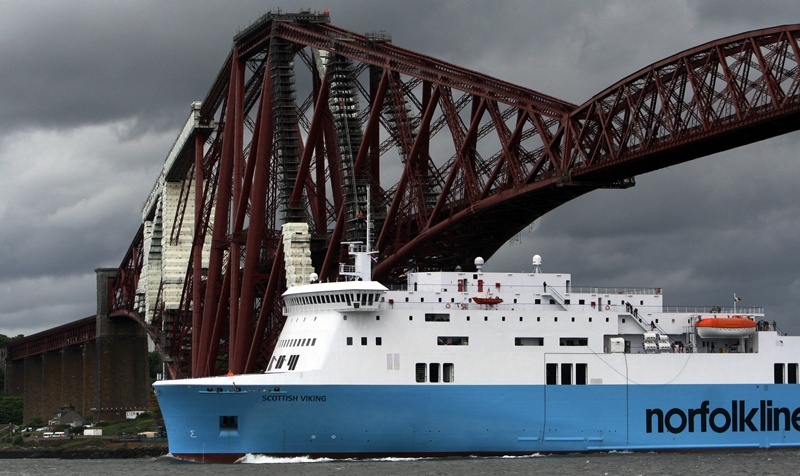Fife politicians have united to press for a rethink over the Rosyth passenger ferry following an announcement that thousands of continental travellers are now arriving in Newcastle and heading straight to Scotland.
“However, we saw potential in enhancing the freight service to meet increased demand from the sector.
“We remain firmly focused on creating a successful freight route between Rosyth and Zeebrugge following the expansion of the service in January.
“The route provides the only direct haulage link between Scotland and the continent and continues to bring significant benefits to the Fife economy.”
DFDS Seaways said passenger traffic was boosted in particular by German coach operators who ferried more than 17,000 German tourists north of the border.
The company said last year the daily Newcastle-Amsterdam route catered for a record 555,000 passengers. Statistics revealed that Holland and Germany are the main source markets for tourists heading to Scotland, while the largest growth sector was the over-65s German coach market.
DFDS Seaways’ passenger director John Crummie said, “We have seen an increasing trend over the last few years of German and Dutch people travelling on our Amsterdam to Newcastle route to make Scotland their final destination.
“We are very pleased to see the valuable contribution the route is making to Scotland’s tourism economy, and in particular those towns and regions outwith the cities.”
He added visitors found Scots friendly and helpful and German visitors also rated the service as having good motorway connections to east and west Scotland.
“We have worked very closely with VisitScotland to promote Scotland as a holiday destination for several years now. As well as attracting continental travellers, the route has also proven popular with Scots using it to reach a variety of destinations across Europe.
“Last year, Scots passengers provided a major boost to our travel figures, with a substantial percentage of the 555,000 travellers originating in Scotland.
“While 2010 was a record year for our route, we see no reason why this trend cannot continue into 2011 and beyond.”
Ferry campaigner Jack Pryde, from west Fife, met transport minister Keith Brown at the Scottish Parliament to explain about the loss of the passenger service and its implications to both the Scottish traveller and those from mainland Europe.
“The minister, while very supportive of having a direct ferry to Europe, confirmed that there are regular on-going discussions with the operator DFDS. However, EU state aid rules prevented any further subsidy for a passenger only service,” said Mr Pryde.
“The reintroduction of a ferry service would be very dependent on the success of the existing freight service and also the availability of a suitable ship.”
DFDS Seaways pulled passenger services from the Rosyth-Zeebrugge route last December and since then has introduced an enhanced freight service, operating two ships making four departures a week from each port.
Now the company has revealed that coachloads of German and Dutch visitors are giving Scotland’s tourism industry a boost. Nearly 60% of Dutch and German passengers sailing into the UK on its Newcastle-Amsterdam ferry are bypassing England to choose Scotland as their final destination.
While that is good news for Scotland’s economy, it has prompted local politicians to question why, if the market is there, the company can’t give customers a direct route to Fife.
Rosyth SNP councillor Douglas Chapman said, “These figures released by DFDS today suggest that there is a strong commercial market for tourists who want to travel in both directions and take holidays in Scotland, either by coach or to travel independently with their car, caravan or camper van.
“Given that DFDS have admitted that they could fill a ship twice over in the summer months underlines the strength of our case to have a direct Euro ferry service into Rosyth.”
Mid Scotland and Fife Labour MSP John Park, who secured cross-party support for his motion to reinstate the passenger ferry service in the Scottish Parliament last year, said, “When I met with them in September I expressed my concerns at that time about the lack of passenger services at Rosyth.
“They said then they would need more investment in terms of trying to find an appropriate vessel to us. All politicians have to work with the company in some way to find out how we could get a vessel to help get people into Rosyth.”
Mr Park said he understood the significant need to get freight services up and running and sustain that side of the business.
“But Scottish people would want a direct service to the continent, too. It isn’t just about people coming to Scotland it is also an opportunity for people living in Scotland to go to the continent direct instead of sitting in cars driving to other ports.
“We need to look at this again,” he added.
A spokesman for DFDS Seaways said, “Our position has not changed in that the passenger service from Rosyth had to be withdrawn because it was identified as a loss-making route, with no prospect of the position changing in the longer term.”
Continued…
